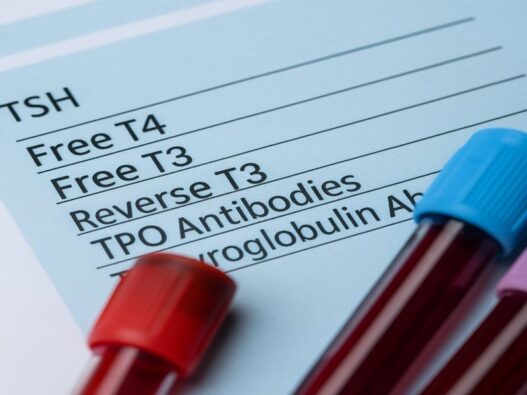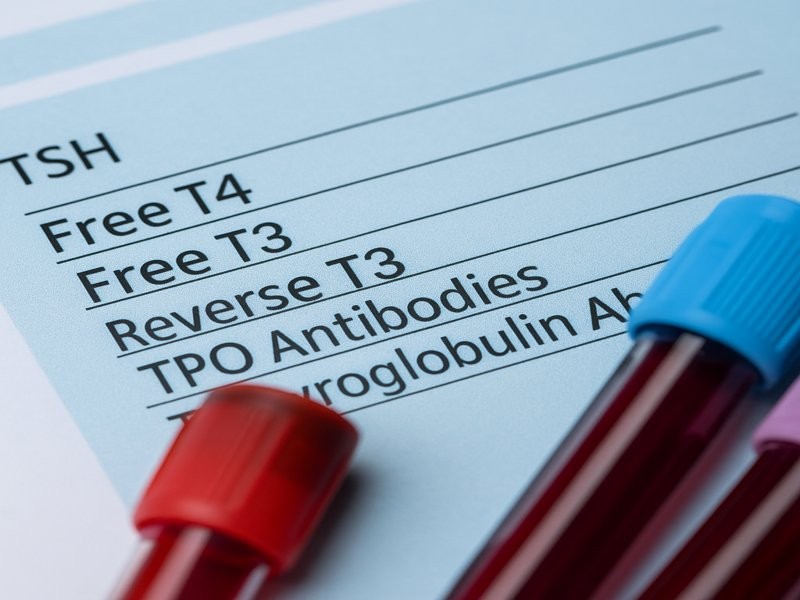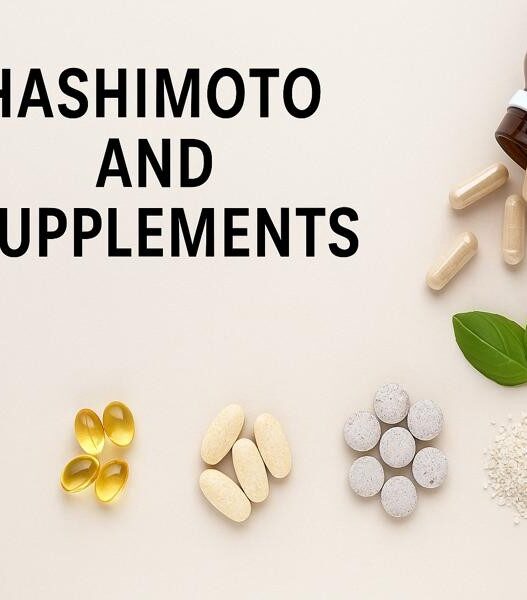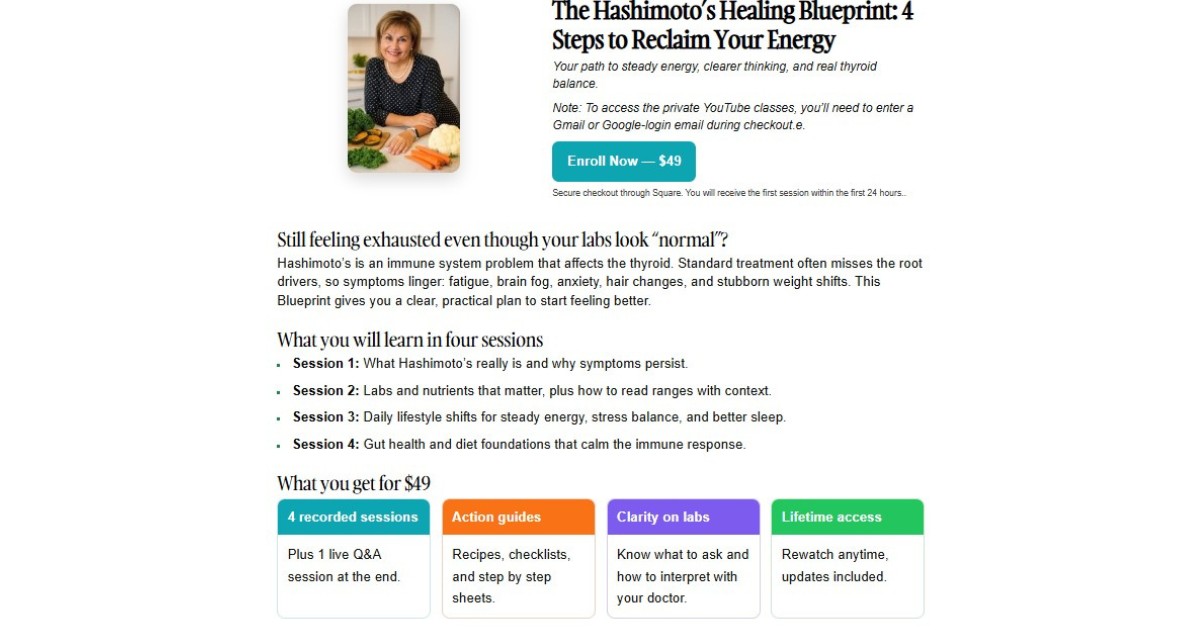Hashimoto’s Tests Guide: Why Standard Labs Miss the Real Problem
When I first began to feel like my body was shutting down—no energy, brain fog, hair falling out—I didn’t know it was Hashimoto’s. I saw doctor after doctor, but all they ran was TSH and T4. “Your levels are normal,” they said. “It’s probably stress or hormones.” Or worse, they implied it was all in my head and they prescribed antidepressants.
But they were wrong. And if you’re reading this, you may know the feeling.
Like I explain in my book From Pain to Wellness: Overcoming Autoimmune Diseases, an Undisclosed Epidemic, standard lab work doesn’t always catch autoimmune thyroid disease. TSH alone can miss Hashimoto’s completely. You need to check antibodies, nutrient levels, inflammation markers, and conversion rates between hormones. That’s why understanding which labs to request is critical. You deserve better than a vague “everything looks fine.”
Eventually, I had to take matters into my own hands. I learned how to ask for the right labs. I researched what they meant. I began to understand my body. That was the beginning of real healing.
This Hashimoto’s Tests Guide is what I wish I had back then. It walks you through the exact thyroid and antibody tests you need, how to interpret them, and why most conventional doctors miss the big picture.
You’re not crazy. You’re not lazy. You’re not alone.
And yes, your labs might be “normal,” but that doesn’t mean your thyroid is okay. If you’re tired of feeling ignored or confused by your lab results, you’re in the right place.
Want a printable test guide?
Hashimoto’s Tests Guide: Understanding Thyroid Hormones and T4 Conversion
Let’s break this down simply. Your thyroid is a small gland in your neck, but it plays a massive role in how you feel—energy, metabolism, mood, digestion, temperature regulation, and even heart rate.
To understand your Hashimoto’s Tests Guide, we need to start here.
T4 Conversion: Two Different Paths
TSH (Thyroid-Stimulating Hormone): This comes from your brain. It tells your thyroid what to do, like a manager giving orders.
T4 (Thyroxine): This is mostly inactive. It’s stored and needs to be converted to become useful.
Free T3 (Triiodothyronine): This is the active hormone. It’s what fuels your cells and your life. 80% comes from T4 conversion in the liver, gut, and kidneys.
Reverse T3 (rT3): is also made from T4, but it’s inactive; it blocks T3 receptors when your body is under stress or inflammation.
Now here’s the kicker: you can have a “normal” TSH and plenty of T4, but if your body converts too much of it into Reverse T3, you won’t feel well. Your cells won’t get the T3 they need, and symptoms continue.
Why This Matters in Hashimoto’s
Which path T4 takes depends on nutrient status, inflammation, stress. That’s why it’s not just about how much T4 you have. It’s about what your body does with it. Understanding these hormones is the first step in making sense of your Hashimoto’s thyroid tests. You can’t heal what you don’t measure properly. And this is what I want to achieve with this Hashimoto’s Test Guide.
As I mention in From Pain to Wellness: Overcoming Autoimmune Diseases, an Undisclosed Epidemic, doctors rarely talk about this pathway. But it matters. A lot! My lab looked “normal,” yet I felt like a zombie. Once I tested Free T3 and rT3, everything made sense.
An article in Rupa Health shows the connection between the stress and the thyroid health.
Hashimoto’s Tests Guide Tip: Always test Free T3 and Reverse T3 alongside TSH and Free T4. The whole picture reveals how well your thyroid is really working.
Hashimoto’s Tests Guide: T1 and T2 Hormones — What About Them?
Most people think thyroid health is only about T4 and T3. But the thyroid also produces T1 (monoiodothyronine) and T2 (diiodothyronine)—hormones often overlooked in testing.
Standard panels ignore them. Conventional medicine calls them “non-active,” mainly because we’ve only begun to study their roles. That doesn’t mean they’re unimportant..
However, some research (especially in functional medicine) suggests:
-
T2 may help with metabolism and fat-burning
-
T1 may have roles in neurological function and anti-inflammatory effects
Evidence is growing that T2 plays a role in metabolism. For example, a 2017 study published in PubMed found that 3,5‑T2 (a type of T2) can regulate energy use at the cellular level, especially in mitochondria. This lets T2 boost energy output faster than standard thyroid hormones.
Meanwhile, thyroid hormones are especially critical for brain development and function as this study shows. They guide how nerve and glial cells form, migrate, and connect—even into adulthood. Though this doesn’t focus on T1 specifically, it shows just how vital the full spectrum of thyroid hormones is for neurological health.
I personally don’t test for T1 and T2, mostly because standard labs don’t offer them. Still, I think it’s important to acknowledge that the thyroid is more complex than we’re told. It’s not just a TSH–T4–T3 machine.
Understanding this helps reinforce why a comprehensive Hashimoto’s Tests Guide must go beyond the basics. Especially when your symptoms don’t match your lab results.
Hashimoto’s Tests Guide: Thyroid Function Tests to Know
Getting the right lab tests is only part of the puzzle. You also need to understand what each number means. Many people are told their thyroid is “fine” based on outdated ranges. In reality, those values may not be ideal for someone with Hashimoto’s.
Here’s a breakdown of the most important thyroid hormone tests included in this Hashimoto’s Tests Guide—and the optimal ranges for people with autoimmune thyroid disease.
1. TSH (Thyroid-Stimulating Hormone)
What it does: This hormone comes from the pituitary gland and tells your thyroid to work harder. Think of it like a thermostat reading.
Lab range: 0.4 – 4.5 μIU/mL
Optimal for Hashimoto’s: 0.5 – 2.5 μIU/mL
If your TSH is high, your body might be under-producing thyroid hormones. If it’s too low, you could be overmedicated. But TSH alone doesn’t tell the full story. As I mention in From Pain to Wellness: Overcoming Autoimmune Diseases, an Undisclosed Epidemic, my TSH looked “normal” for years—yet I felt anything but.
2. Free T4 (Free Thyroxine)
What it does: This is your storage hormone. It’s inactive until converted to T3.
-
Lab range: 0.8 – 1.8 ng/dL
-
Optimal: 1.2 – 1.5 ng/dL
If Free T4 is low, your thyroid might be slowing down. But even with decent T4, you can feel unwell if conversion to T3 is poor. This is common with Hashimoto’s.
3. Free T3 (Free Triiodothyronine)
What it does: This is the active thyroid hormone that powers your metabolism, mood, and energy. It’s what your cells actually use.
-
Lab range: 2.3 – 4.2 pg/mL
-
Optimal: 3.2 – 4.0 pg/mL
Even if your TSH and Free T4 are fine, low Free T3 can explain many symptoms. Brain fog, slow digestion, cold hands, and fatigue often show up when Free T3 is below optimal. In my case, Free T3 testing was a turning point in understanding what my body truly needed.
4. Reverse T3 (rT3)
What it does: This is the “brake” hormone. It blocks active T3 from entering your cells.
Lab range: 9 – 24 ng/dL
Optimal: Under 15 ng/dL
Ideal Free T3:rT3 ratio: At least 2:1. You can calculate this ratio by dividing your Free T3 value (in pg/mL) by your rT3 (in ng/dL). Example: If Free T3 = 3.2 and rT3 = 16, the ratio is 3.2 ÷ 16 = 0.2—not optimal.
If you’re under stress or dealing with inflammation, your body might convert too much T4 into rT3 instead of Free T3. The result? You feel exhausted even when labs look okay. High cortisol, low calories, or infections can drive this up.
Hashimoto’s Tests Guide: Thyroid Autoimmunity Markers You Shouldn’t Ignore
When we talk about Hashimoto’s, we can’t stop at hormones. Antibody testing is crucial. That’s because Hashimoto’s is an autoimmune disease. The problem isn’t just a “lazy thyroid.” It’s your immune system attacking it.
In this part of the Hashimoto’s Tests Guide, we’ll look at the two key thyroid antibodies and how to interpret them.
5. TPO Antibodies (Thyroid Peroxidase Antibodies)
What they do: These antibodies attack thyroid peroxidase—an enzyme your thyroid uses to produce hormones.
Lab reference range: < 35 IU/mL
Hashimoto’s positive: > 35 IU/mL
Optimal: The lower, the better
Over 90% of people with Hashimoto’s have elevated TPO antibodies. Even if your TSH looks normal, high TPO indicates an ongoing immune attack.
As I explain in From Pain to Wellness: Overcoming Autoimmune Diseases, an Undisclosed Epidemic, I had TPO antibodies long before my thyroid failed. Catching them early might help reduce long-term damage.
TPO levels can fluctuate. Some people panic when the number rises. Instead, focus on overall trends and symptoms. High antibodies mean inflammation is still active—even when you’re on medication.
6. Tg Antibodies (Thyroglobulin Antibodies)
What they do: These antibodies attack thyroglobulin, the protein building block used to make thyroid hormones.
Lab reference range: < 20 IU/mL
Hashimoto’s positive: > 20 IU/mL
Optimal: Ideally undetectable
Some people with Hashimoto’s only test positive for TgAb. That’s why this test should always be ordered along with TPO. It’s easy to miss a diagnosis if only one is tested.
Adding this section to the Hashimoto’s Tests Guide helps prevent false negatives and uncovers silent thyroid inflammation before permanent damage sets in.
Hashimoto’s Tests Guide: Thyroid Structure and Imaging
While blood work is essential, imaging can reveal what antibodies and hormones can’t. That’s why this Hashimoto’s Tests Guide also includes thyroid structure testing—especially important if antibody tests are negative but symptoms persist.
7. Thyroid Structure Test
What it is: A non-invasive imaging test that shows the size, shape, and texture of your thyroid.
Why it matters:
-
Confirms inflammation
-
Detects nodules or goiter
-
Monitors tissue shrinkage (common in late-stage Hashimoto’s)
In Hashimoto’s, the thyroid may look small, irregular, or full of tiny dark spots (called hypoechoic areas), which indicate chronic inflammation.
Ultrasounds are especially helpful for those with “seronegative Hashimoto’s”—where antibodies are normal but autoimmune damage is present.
In this Hashimoto’s Tests Guide, I always recommend a baseline thyroid ultrasound at diagnosis and follow-up imaging every 1–2 years, or sooner if nodules are found.
Hashimoto’s Tests Guide: Nutrient Deficiencies That Impact Your Thyroid
This is one area I feel very strongly about—and one that’s often overlooked.
Low levels of iron, B12, zinc, selenium, or vitamin D can directly affect how your thyroid hormones are produced, converted, and used. And yes, they can also influence your lab results.
Hashimoto’s often comes with poor digestion and nutrient absorption. These can worsen fatigue, hair loss, or mental fog.
8. Vitamin D (25-Hydroxy Vitamin D)
Lab reference range: 30 – 100 ng/mL
Optimal range: 50 – 80 ng/mL
Low vitamin D is common in Hashimoto’s and other autoimmune diseases. It helps regulate immune function and may even reduce antibody levels. A 2018 review showed vitamin D deficiency was significantly more frequent in patients with autoimmune thyroiditis
9. Vitamin B12
Lab reference range: 200 – 1100 pg/mL
Optimal range: 600 – 900 pg/mL
Low B12 can mimic thyroid symptoms: fatigue, dizziness, numbness. It’s often low in Hashimoto’s patients, especially those with autoimmune gastritis (which I also deal with). If your B12 is borderline, ask your doctor to test MMA (Methylmalonic Acid) for a more accurate picture.
10. Ferritin (Iron Storage)
Lab reference range: 12 – 150 ng/mL (women)
Optimal for thyroid health: 70 – 90 ng/mL
Low ferritin = hair loss, cold hands, fatigue, even if other labs are okay. It’s a key part of the Hashimoto’s Tests Guide because iron is needed to convert T4 into T3. Too much iron, however, may indicate inflammation or infection.
11. Zinc
Lab reference range: 56 – 134 μg/dL
Optimal range: 90 – 120 μg/dL
Zinc helps convert T4 to T3 and supports immune regulation. Low zinc is linked with worsened thyroid function and more frequent infections.
12. Selenium
Lab reference range: 70 – 150 μg/L
Optimal range: 100 – 130 μg/L
Selenium reduces TPO antibodies and supports antioxidant defense. But be careful: selenium supplements can be toxic in high doses, so test before supplementing.
13. Magnesium (RBC)
Lab reference range: 4.2 – 6.8 mg/dL
Optimal: 6.0 – 6.5 mg/dL RBC magnesium)
Magnesium is involved in thyroid hormone production, adrenal balance, and cellular energy. Many Hashimoto’s patients are deficient, especially if they deal with stress, muscle cramps, or constipation. Low magnesium may worsen sleep and anxiety symptoms.
RBC magnesium is a better measure of cellular magnesium status than serum levels. Aim for 6.0–6.5 mg/dL to support thyroid and adrenal health.
14. Homocysteine
Lab range: 4–15 μmol/L
Optimal: 6 – 8 μmol/L
This marker reflects B12, B6, and folate status. High homocysteine can increase inflammation and cardiovascular risk—something important in thyroid patients, especially with low T3.
Elevated homocysteine increases oxidative stress and inflammation, which can interfere with thyroid hormone conversion and increase the autoimmune burden.
15. Iron Panel (Serum Iron, TIBC, and Transferrin Saturation)
This section of the Hashimoto’s Tests Guide isn’t just about lab numbers—it’s about understanding how your whole system works together. Nutrients are the co-pilots for your thyroid. Without them, even medication won’t work well.
While ferritin shows iron storage, a full iron panel shows what’s circulating and available.
Serum Iron (Iron in the blood)
- Reference: 60 – 170 µg/dL
- Optimal: 85 – 130 µg/dL
TIBC (Total Iron Binding Capacity)
- Reference: 240 – 450 µg/dL
- Optimal: 250 – 350 µg/dL
Transferrin Saturation (how much iron is bound and usable)
Reference: 20% – 50%
Optimal: 30% – 40%
Why this matters in Hashimoto’s: low serum iron or transferrin saturation can mean your thyroid hormones aren’t being delivered effectively—even if ferritin is “normal.” Iron is required to make thyroid peroxidase (TPO), which is needed to create thyroid hormones. If iron is off, your whole thyroid system can suffer.
Hashimoto’s Tests Guide: Inflammation & Other Useful Labs
16. hs-CRP (High Sensitivity C-Reactive Protein)
Sometimes your thyroid labs look normal, but something still feels off. That’s where these additional tests come in. They help reveal silent inflammation, chronic stress, or underlying immune dysfunction. All of these can block healing and worsen Hashimoto’s symptoms.
When I was struggling with unexplained flares, fatigue, and joint pain, these inflammation markers were often the missing piece. As I describe in From Pain to Wellness: Overcoming Autoimmune Diseases, an Undisclosed Epidemic, learning how to read these tests helped me get ahead of flare-ups before they took over.
-
What it is: A marker for low-grade inflammation in the body.
-
Lab range: < 3.0 mg/L
-
Optimal: < 1.0 mg/L
This test is easy to overlook, but crucial. Chronic inflammation, even low-grade, can affect thyroid conversion and immune function. In people with Hashimoto’s, CRP tends to rise during flare-ups. Keeping this low supports the effectiveness of your Hashimoto’s treatment plan.
17. ESR (Erythrocyte Sedimentation Rate)
-
What it is: A general marker of inflammation, especially in autoimmune conditions.
-
Lab range: 0 – 20 mm/hr (for women)
-
Optimal: Lower end of the range, ideally under 10 mm/hr
While not specific to thyroid issues, ESR helps identify ongoing inflammation that may be driving symptoms like fatigue, joint pain, or swelling. In functional medicine, both ESR and hs-CRP are used together to monitor autoimmune activity and track progress.
Hashimoto’s Tests Guide: What Thyroid Labs Can’t Tell You
Lab tests matter. But numbers alone don’t tell the full story. This is where many people with Hashimoto’s get stuck. You’re told “everything looks normal,” yet you still feel exhausted, foggy, or cold all the time. I’ve been there, and I know how frustrating it is.
That’s why in this Hashimoto’s Tests Guide, I want to be clear: your symptoms still matter. Maybe your TSH is within range. Maybe your Free T4 and Free T3 are “fine.” But that doesn’t mean your body is functioning well. It just means your labs fall between population averages. And population averages don’t equal optimal health.
In From Pain to Wellness: Overcoming Autoimmune Diseases, an Undisclosed Epidemic, I wrote how I once relied too much on lab results and ignored how I felt. That delayed my healing.
So here’s what thyroid tests often miss:
They don’t show how well hormones are getting into your cells.
They don’t measure how your body is reacting to stress.
They don’t explain symptoms caused by mold, toxins, or infections.
They ignore nutrient status unless you test for it directly.
This Hashimoto’s Tests Guide gives you tools to understand your labs. But it also reminds you: healing isn’t just about numbers. It’s about function, absorption, conversion, and inflammation. Those require a broader lens.
If you’ve been told your thyroid is “fine” but feel far from it, don’t stop here. Dig deeper. Look at the full pattern, not just a single test.
Listening to your body is just as important as reading your labs.
Hashimoto’s Tests Guide: How Often Should You Test?
When I was first diagnosed, no one told me how often I should test. I thought once a year was enough. But with Hashimoto’s, things can shift quickly. Hormones change. Antibodies rise and fall. Nutrient levels dip. That’s why in this Hashimoto’s Tests Guide, I want to walk you through how often I personally check each marker—and why.
You don’t need to overtest. But you also don’t want to miss something important.
Here’s a general timeline to follow:
TSH, Free T3, Free T4
Every 3–6 months
Or 6–8 weeks after changing your medication
TPO and Tg Antibodies
Every 6–12 months
Helpful for tracking autoimmune activity over time
Reverse T3
As needed
Especially if you have low Free T3 but normal TSH and T4
Vitamin D, B12, Ferritin, Iron Panel, Zinc, Selenium
1–2 times a year
Or during symptom flare-ups or major diet changes
Ultrasound
At diagnosis
Then every 1–2 years (or sooner if nodules are found)
This type of regular testing helped me find patterns in my health. I stopped guessing. I started connecting the dots. That’s why this Hashimoto’s Tests Guide is here—to help you do the same.
Test smart. Track symptoms. Don’t wait for your body to scream before you take action.
Want a printable test guide? Sign up below and I'll email you the complete Hashimoto's Tests Checklist (PDF) with lab names, optimanl ranges and how often to test.
You Deserve Better Than "Normal"
“Your labs are normal.”
If I had a dollar for every time I heard that before my diagnosis, I could’ve paid for all the functional testing myself. But deep down, I knew something wasn’t right. And maybe you do too. That’s exactly why this Hashimoto’s Tests Guide exists.
When your labs say one thing, but your body feels another, it’s not in your head. The truth is, “normal” doesn’t always mean optimal. And it certainly doesn’t mean healthy. Especially with Hashimoto’s.
TSH might be in range, but what about Free T3? Or reverse T3? Or antibodies? Or ferritin, zinc, and selenium? If no one’s checking the full picture, of course nothing changes.
As I share in From Pain to Wellness: Overcoming Autoimmune Diseases, an Undisclosed Epidemic, it wasn’t until I demanded a deeper look that things began to shift. That’s why I now test smarter. I watch trends, not just numbers. And most importantly, I trust how I feel—not just what a report says.
You deserve that too.
This Hashimoto’s Tests Guide isn’t just about labs—it’s about reclaiming your power. It’s about saying no to vague answers and yes to real healing. So if you’ve been dismissed or gaslit or told you’re fine when you’re clearly not—this is your reminder:
You’re not alone. You’re not lazy. You’re not making it up.
You’re just missing the right tests. But not anymore.
If this post helped you, please share it with a friend, a support group, or anyone still struggling to find answers. We need to raise awareness—one empowered patient at a time.






















